Analyzing Price Fluctuations in the Malaysian Durian Market
VerifiedAdded on 2020/04/15
|10
|2475
|813
AI Summary
The essay critically examines Malaysia's durian industry, highlighting its global demand and production significance. It delves into supply and demand forces affecting prices within Malaysia, particularly focusing on domestic shortages due to large exports to China. The analysis reveals how these dynamics lead to increased prices in local markets and affect neighboring countries like Singapore. Regions such as northern, east coastal, west, south, and central areas are the primary durian production zones. The study concludes that while export opportunities enhance income for Malaysian farmers, strategic management of this natural monopoly could further amplify benefits.
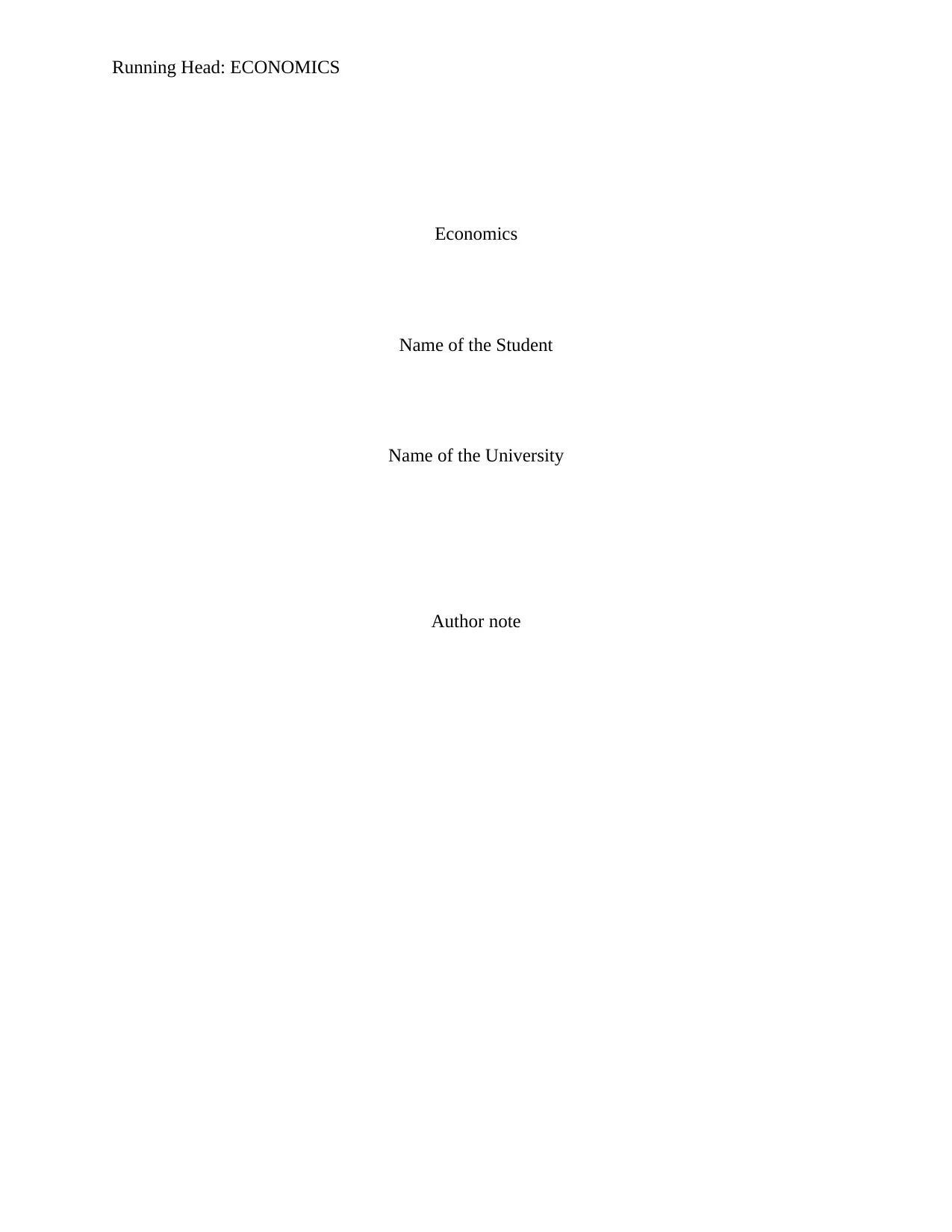
Running Head: ECONOMICS
Economics
Name of the Student
Name of the University
Author note
Economics
Name of the Student
Name of the University
Author note
Paraphrase This Document
Need a fresh take? Get an instant paraphrase of this document with our AI Paraphraser
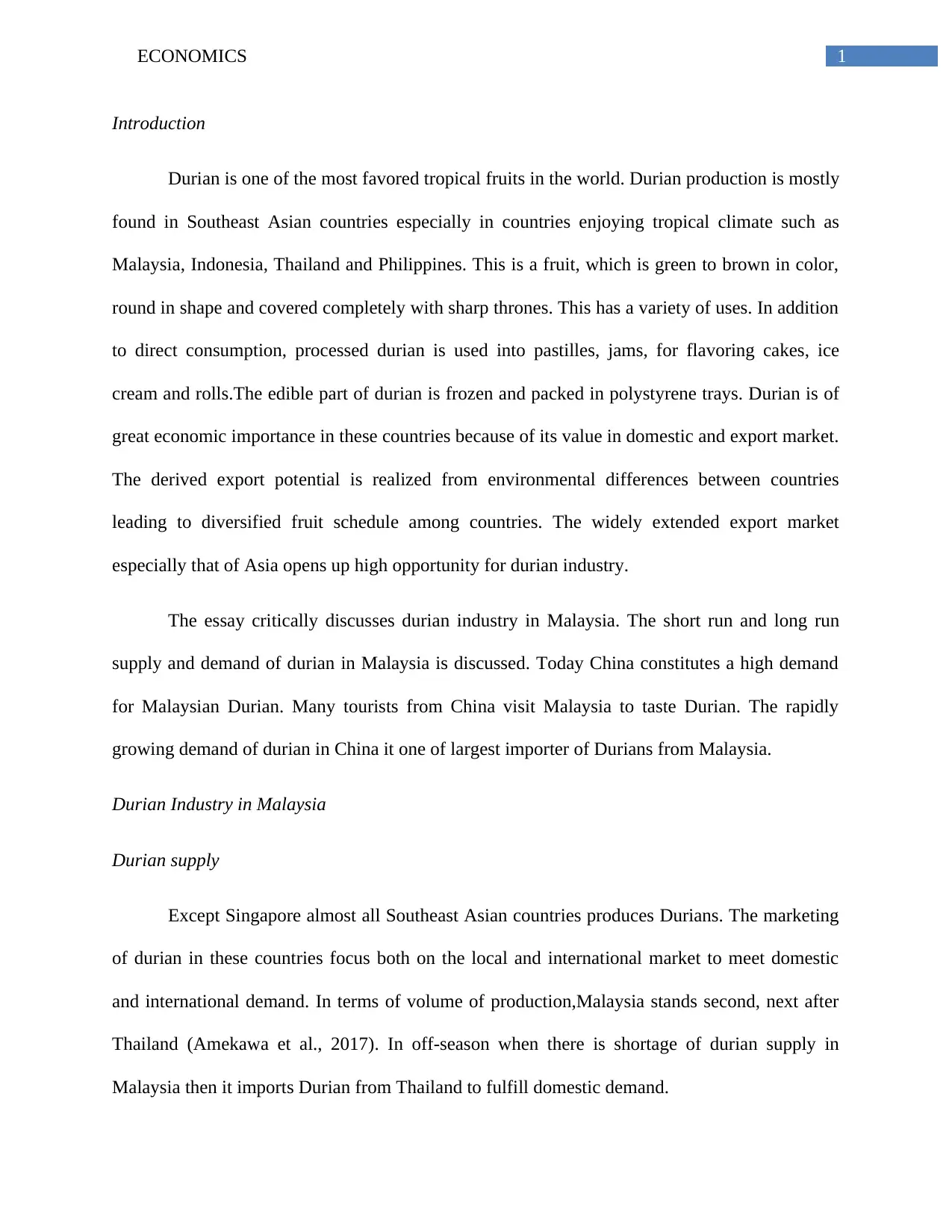
1ECONOMICS
Introduction
Durian is one of the most favored tropical fruits in the world. Durian production is mostly
found in Southeast Asian countries especially in countries enjoying tropical climate such as
Malaysia, Indonesia, Thailand and Philippines. This is a fruit, which is green to brown in color,
round in shape and covered completely with sharp thrones. This has a variety of uses. In addition
to direct consumption, processed durian is used into pastilles, jams, for flavoring cakes, ice
cream and rolls.The edible part of durian is frozen and packed in polystyrene trays. Durian is of
great economic importance in these countries because of its value in domestic and export market.
The derived export potential is realized from environmental differences between countries
leading to diversified fruit schedule among countries. The widely extended export market
especially that of Asia opens up high opportunity for durian industry.
The essay critically discusses durian industry in Malaysia. The short run and long run
supply and demand of durian in Malaysia is discussed. Today China constitutes a high demand
for Malaysian Durian. Many tourists from China visit Malaysia to taste Durian. The rapidly
growing demand of durian in China it one of largest importer of Durians from Malaysia.
Durian Industry in Malaysia
Durian supply
Except Singapore almost all Southeast Asian countries produces Durians. The marketing
of durian in these countries focus both on the local and international market to meet domestic
and international demand. In terms of volume of production,Malaysia stands second, next after
Thailand (Amekawa et al., 2017). In off-season when there is shortage of durian supply in
Malaysia then it imports Durian from Thailand to fulfill domestic demand.
Introduction
Durian is one of the most favored tropical fruits in the world. Durian production is mostly
found in Southeast Asian countries especially in countries enjoying tropical climate such as
Malaysia, Indonesia, Thailand and Philippines. This is a fruit, which is green to brown in color,
round in shape and covered completely with sharp thrones. This has a variety of uses. In addition
to direct consumption, processed durian is used into pastilles, jams, for flavoring cakes, ice
cream and rolls.The edible part of durian is frozen and packed in polystyrene trays. Durian is of
great economic importance in these countries because of its value in domestic and export market.
The derived export potential is realized from environmental differences between countries
leading to diversified fruit schedule among countries. The widely extended export market
especially that of Asia opens up high opportunity for durian industry.
The essay critically discusses durian industry in Malaysia. The short run and long run
supply and demand of durian in Malaysia is discussed. Today China constitutes a high demand
for Malaysian Durian. Many tourists from China visit Malaysia to taste Durian. The rapidly
growing demand of durian in China it one of largest importer of Durians from Malaysia.
Durian Industry in Malaysia
Durian supply
Except Singapore almost all Southeast Asian countries produces Durians. The marketing
of durian in these countries focus both on the local and international market to meet domestic
and international demand. In terms of volume of production,Malaysia stands second, next after
Thailand (Amekawa et al., 2017). In off-season when there is shortage of durian supply in
Malaysia then it imports Durian from Thailand to fulfill domestic demand.
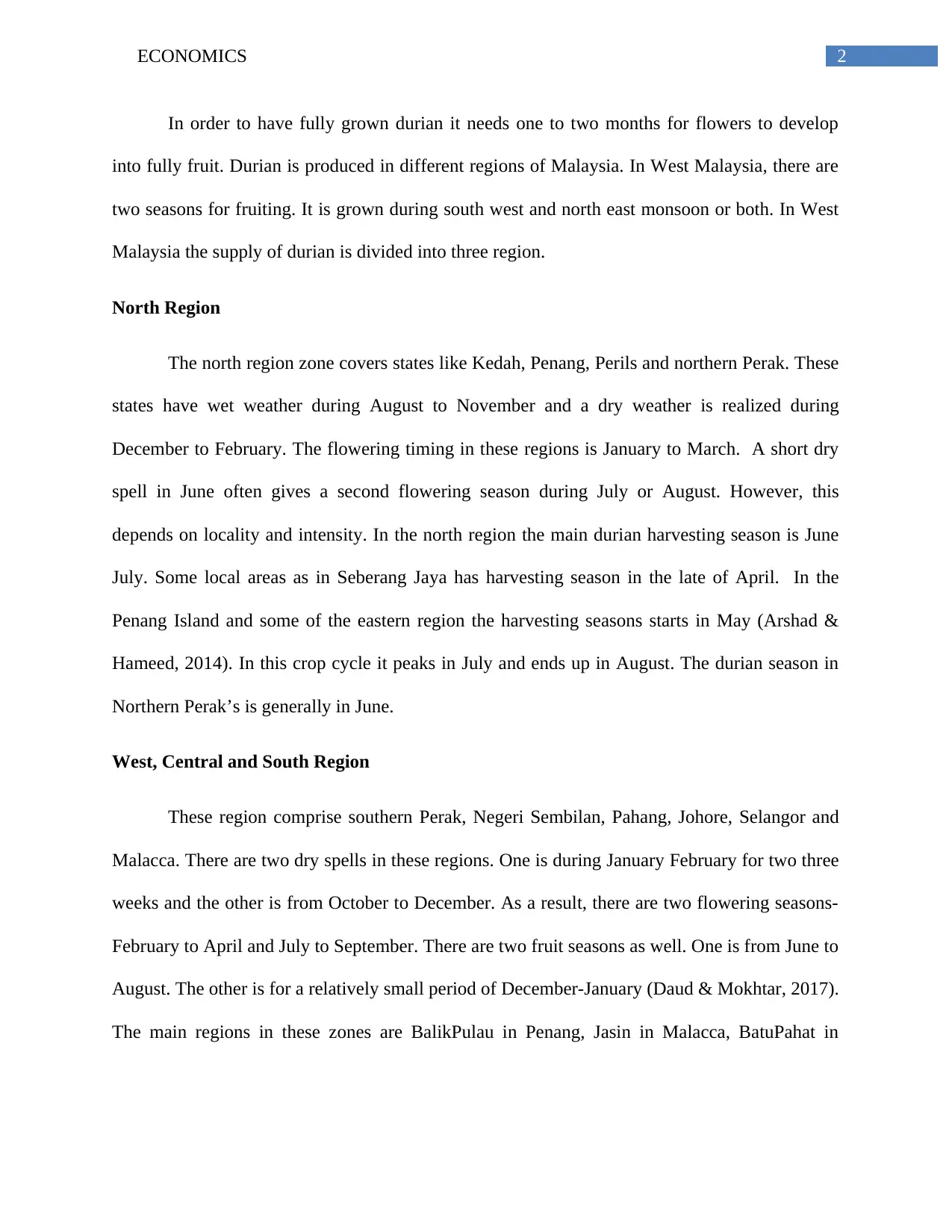
2ECONOMICS
In order to have fully grown durian it needs one to two months for flowers to develop
into fully fruit. Durian is produced in different regions of Malaysia. In West Malaysia, there are
two seasons for fruiting. It is grown during south west and north east monsoon or both. In West
Malaysia the supply of durian is divided into three region.
North Region
The north region zone covers states like Kedah, Penang, Perils and northern Perak. These
states have wet weather during August to November and a dry weather is realized during
December to February. The flowering timing in these regions is January to March. A short dry
spell in June often gives a second flowering season during July or August. However, this
depends on locality and intensity. In the north region the main durian harvesting season is June
July. Some local areas as in Seberang Jaya has harvesting season in the late of April. In the
Penang Island and some of the eastern region the harvesting seasons starts in May (Arshad &
Hameed, 2014). In this crop cycle it peaks in July and ends up in August. The durian season in
Northern Perak’s is generally in June.
West, Central and South Region
These region comprise southern Perak, Negeri Sembilan, Pahang, Johore, Selangor and
Malacca. There are two dry spells in these regions. One is during January February for two three
weeks and the other is from October to December. As a result, there are two flowering seasons-
February to April and July to September. There are two fruit seasons as well. One is from June to
August. The other is for a relatively small period of December-January (Daud & Mokhtar, 2017).
The main regions in these zones are BalikPulau in Penang, Jasin in Malacca, BatuPahat in
In order to have fully grown durian it needs one to two months for flowers to develop
into fully fruit. Durian is produced in different regions of Malaysia. In West Malaysia, there are
two seasons for fruiting. It is grown during south west and north east monsoon or both. In West
Malaysia the supply of durian is divided into three region.
North Region
The north region zone covers states like Kedah, Penang, Perils and northern Perak. These
states have wet weather during August to November and a dry weather is realized during
December to February. The flowering timing in these regions is January to March. A short dry
spell in June often gives a second flowering season during July or August. However, this
depends on locality and intensity. In the north region the main durian harvesting season is June
July. Some local areas as in Seberang Jaya has harvesting season in the late of April. In the
Penang Island and some of the eastern region the harvesting seasons starts in May (Arshad &
Hameed, 2014). In this crop cycle it peaks in July and ends up in August. The durian season in
Northern Perak’s is generally in June.
West, Central and South Region
These region comprise southern Perak, Negeri Sembilan, Pahang, Johore, Selangor and
Malacca. There are two dry spells in these regions. One is during January February for two three
weeks and the other is from October to December. As a result, there are two flowering seasons-
February to April and July to September. There are two fruit seasons as well. One is from June to
August. The other is for a relatively small period of December-January (Daud & Mokhtar, 2017).
The main regions in these zones are BalikPulau in Penang, Jasin in Malacca, BatuPahat in
⊘ This is a preview!⊘
Do you want full access?
Subscribe today to unlock all pages.

Trusted by 1+ million students worldwide
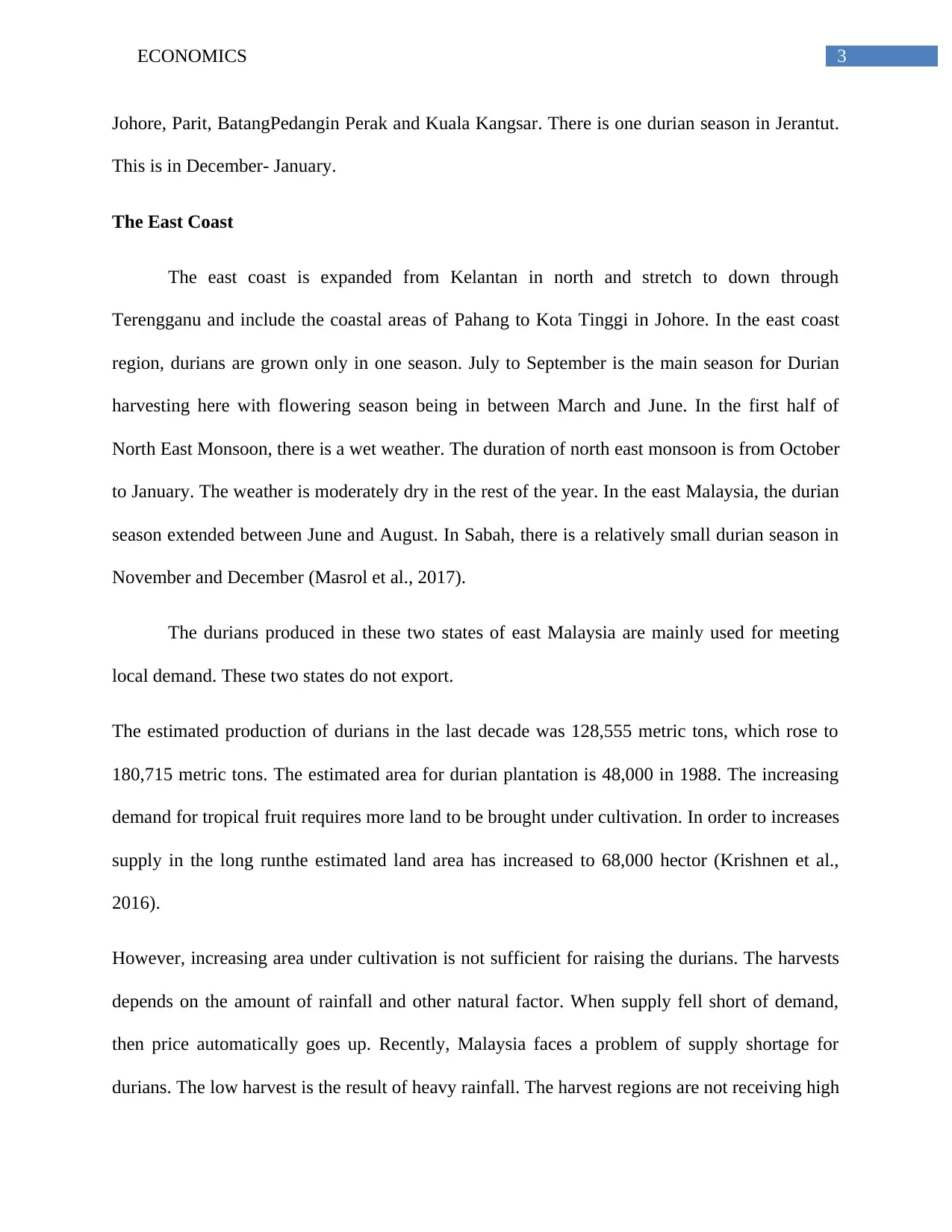
3ECONOMICS
Johore, Parit, BatangPedangin Perak and Kuala Kangsar. There is one durian season in Jerantut.
This is in December- January.
The East Coast
The east coast is expanded from Kelantan in north and stretch to down through
Terengganu and include the coastal areas of Pahang to Kota Tinggi in Johore. In the east coast
region, durians are grown only in one season. July to September is the main season for Durian
harvesting here with flowering season being in between March and June. In the first half of
North East Monsoon, there is a wet weather. The duration of north east monsoon is from October
to January. The weather is moderately dry in the rest of the year. In the east Malaysia, the durian
season extended between June and August. In Sabah, there is a relatively small durian season in
November and December (Masrol et al., 2017).
The durians produced in these two states of east Malaysia are mainly used for meeting
local demand. These two states do not export.
The estimated production of durians in the last decade was 128,555 metric tons, which rose to
180,715 metric tons. The estimated area for durian plantation is 48,000 in 1988. The increasing
demand for tropical fruit requires more land to be brought under cultivation. In order to increases
supply in the long runthe estimated land area has increased to 68,000 hector (Krishnen et al.,
2016).
However, increasing area under cultivation is not sufficient for raising the durians. The harvests
depends on the amount of rainfall and other natural factor. When supply fell short of demand,
then price automatically goes up. Recently, Malaysia faces a problem of supply shortage for
durians. The low harvest is the result of heavy rainfall. The harvest regions are not receiving high
Johore, Parit, BatangPedangin Perak and Kuala Kangsar. There is one durian season in Jerantut.
This is in December- January.
The East Coast
The east coast is expanded from Kelantan in north and stretch to down through
Terengganu and include the coastal areas of Pahang to Kota Tinggi in Johore. In the east coast
region, durians are grown only in one season. July to September is the main season for Durian
harvesting here with flowering season being in between March and June. In the first half of
North East Monsoon, there is a wet weather. The duration of north east monsoon is from October
to January. The weather is moderately dry in the rest of the year. In the east Malaysia, the durian
season extended between June and August. In Sabah, there is a relatively small durian season in
November and December (Masrol et al., 2017).
The durians produced in these two states of east Malaysia are mainly used for meeting
local demand. These two states do not export.
The estimated production of durians in the last decade was 128,555 metric tons, which rose to
180,715 metric tons. The estimated area for durian plantation is 48,000 in 1988. The increasing
demand for tropical fruit requires more land to be brought under cultivation. In order to increases
supply in the long runthe estimated land area has increased to 68,000 hector (Krishnen et al.,
2016).
However, increasing area under cultivation is not sufficient for raising the durians. The harvests
depends on the amount of rainfall and other natural factor. When supply fell short of demand,
then price automatically goes up. Recently, Malaysia faces a problem of supply shortage for
durians. The low harvest is the result of heavy rainfall. The harvest regions are not receiving high
Paraphrase This Document
Need a fresh take? Get an instant paraphrase of this document with our AI Paraphraser
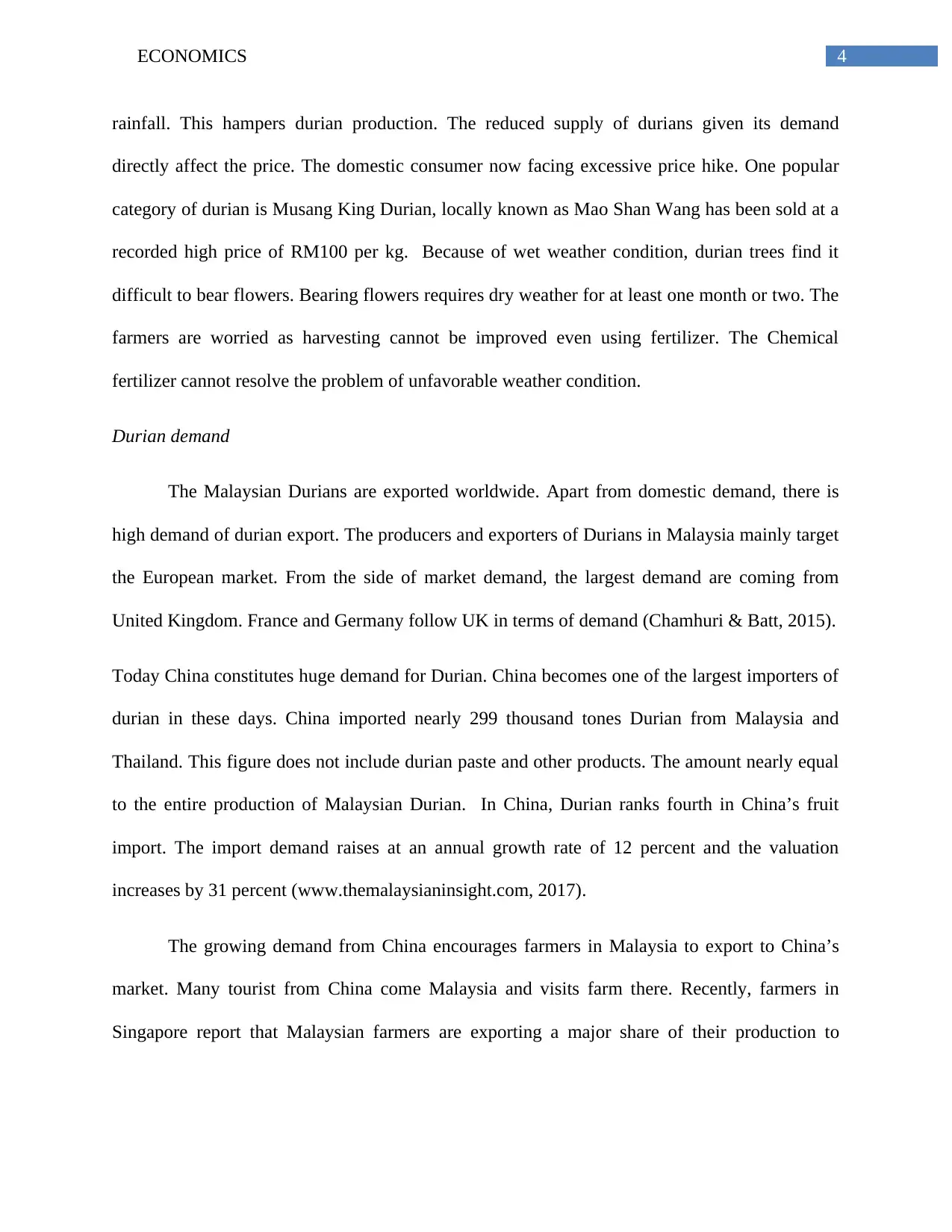
4ECONOMICS
rainfall. This hampers durian production. The reduced supply of durians given its demand
directly affect the price. The domestic consumer now facing excessive price hike. One popular
category of durian is Musang King Durian, locally known as Mao Shan Wang has been sold at a
recorded high price of RM100 per kg. Because of wet weather condition, durian trees find it
difficult to bear flowers. Bearing flowers requires dry weather for at least one month or two. The
farmers are worried as harvesting cannot be improved even using fertilizer. The Chemical
fertilizer cannot resolve the problem of unfavorable weather condition.
Durian demand
The Malaysian Durians are exported worldwide. Apart from domestic demand, there is
high demand of durian export. The producers and exporters of Durians in Malaysia mainly target
the European market. From the side of market demand, the largest demand are coming from
United Kingdom. France and Germany follow UK in terms of demand (Chamhuri & Batt, 2015).
Today China constitutes huge demand for Durian. China becomes one of the largest importers of
durian in these days. China imported nearly 299 thousand tones Durian from Malaysia and
Thailand. This figure does not include durian paste and other products. The amount nearly equal
to the entire production of Malaysian Durian. In China, Durian ranks fourth in China’s fruit
import. The import demand raises at an annual growth rate of 12 percent and the valuation
increases by 31 percent (www.themalaysianinsight.com, 2017).
The growing demand from China encourages farmers in Malaysia to export to China’s
market. Many tourist from China come Malaysia and visits farm there. Recently, farmers in
Singapore report that Malaysian farmers are exporting a major share of their production to
rainfall. This hampers durian production. The reduced supply of durians given its demand
directly affect the price. The domestic consumer now facing excessive price hike. One popular
category of durian is Musang King Durian, locally known as Mao Shan Wang has been sold at a
recorded high price of RM100 per kg. Because of wet weather condition, durian trees find it
difficult to bear flowers. Bearing flowers requires dry weather for at least one month or two. The
farmers are worried as harvesting cannot be improved even using fertilizer. The Chemical
fertilizer cannot resolve the problem of unfavorable weather condition.
Durian demand
The Malaysian Durians are exported worldwide. Apart from domestic demand, there is
high demand of durian export. The producers and exporters of Durians in Malaysia mainly target
the European market. From the side of market demand, the largest demand are coming from
United Kingdom. France and Germany follow UK in terms of demand (Chamhuri & Batt, 2015).
Today China constitutes huge demand for Durian. China becomes one of the largest importers of
durian in these days. China imported nearly 299 thousand tones Durian from Malaysia and
Thailand. This figure does not include durian paste and other products. The amount nearly equal
to the entire production of Malaysian Durian. In China, Durian ranks fourth in China’s fruit
import. The import demand raises at an annual growth rate of 12 percent and the valuation
increases by 31 percent (www.themalaysianinsight.com, 2017).
The growing demand from China encourages farmers in Malaysia to export to China’s
market. Many tourist from China come Malaysia and visits farm there. Recently, farmers in
Singapore report that Malaysian farmers are exporting a major share of their production to
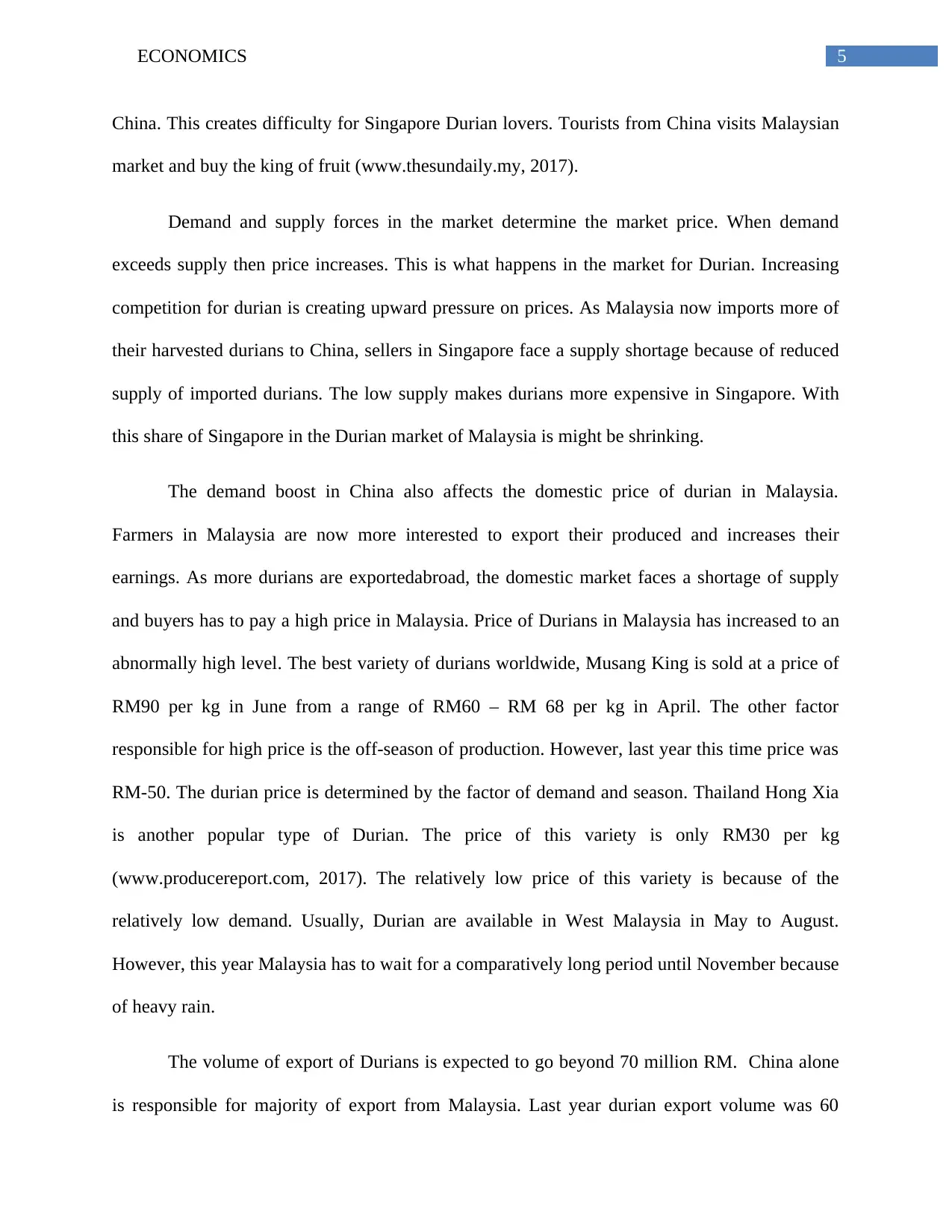
5ECONOMICS
China. This creates difficulty for Singapore Durian lovers. Tourists from China visits Malaysian
market and buy the king of fruit (www.thesundaily.my, 2017).
Demand and supply forces in the market determine the market price. When demand
exceeds supply then price increases. This is what happens in the market for Durian. Increasing
competition for durian is creating upward pressure on prices. As Malaysia now imports more of
their harvested durians to China, sellers in Singapore face a supply shortage because of reduced
supply of imported durians. The low supply makes durians more expensive in Singapore. With
this share of Singapore in the Durian market of Malaysia is might be shrinking.
The demand boost in China also affects the domestic price of durian in Malaysia.
Farmers in Malaysia are now more interested to export their produced and increases their
earnings. As more durians are exportedabroad, the domestic market faces a shortage of supply
and buyers has to pay a high price in Malaysia. Price of Durians in Malaysia has increased to an
abnormally high level. The best variety of durians worldwide, Musang King is sold at a price of
RM90 per kg in June from a range of RM60 – RM 68 per kg in April. The other factor
responsible for high price is the off-season of production. However, last year this time price was
RM-50. The durian price is determined by the factor of demand and season. Thailand Hong Xia
is another popular type of Durian. The price of this variety is only RM30 per kg
(www.producereport.com, 2017). The relatively low price of this variety is because of the
relatively low demand. Usually, Durian are available in West Malaysia in May to August.
However, this year Malaysia has to wait for a comparatively long period until November because
of heavy rain.
The volume of export of Durians is expected to go beyond 70 million RM. China alone
is responsible for majority of export from Malaysia. Last year durian export volume was 60
China. This creates difficulty for Singapore Durian lovers. Tourists from China visits Malaysian
market and buy the king of fruit (www.thesundaily.my, 2017).
Demand and supply forces in the market determine the market price. When demand
exceeds supply then price increases. This is what happens in the market for Durian. Increasing
competition for durian is creating upward pressure on prices. As Malaysia now imports more of
their harvested durians to China, sellers in Singapore face a supply shortage because of reduced
supply of imported durians. The low supply makes durians more expensive in Singapore. With
this share of Singapore in the Durian market of Malaysia is might be shrinking.
The demand boost in China also affects the domestic price of durian in Malaysia.
Farmers in Malaysia are now more interested to export their produced and increases their
earnings. As more durians are exportedabroad, the domestic market faces a shortage of supply
and buyers has to pay a high price in Malaysia. Price of Durians in Malaysia has increased to an
abnormally high level. The best variety of durians worldwide, Musang King is sold at a price of
RM90 per kg in June from a range of RM60 – RM 68 per kg in April. The other factor
responsible for high price is the off-season of production. However, last year this time price was
RM-50. The durian price is determined by the factor of demand and season. Thailand Hong Xia
is another popular type of Durian. The price of this variety is only RM30 per kg
(www.producereport.com, 2017). The relatively low price of this variety is because of the
relatively low demand. Usually, Durian are available in West Malaysia in May to August.
However, this year Malaysia has to wait for a comparatively long period until November because
of heavy rain.
The volume of export of Durians is expected to go beyond 70 million RM. China alone
is responsible for majority of export from Malaysia. Last year durian export volume was 60
⊘ This is a preview!⊘
Do you want full access?
Subscribe today to unlock all pages.

Trusted by 1+ million students worldwide
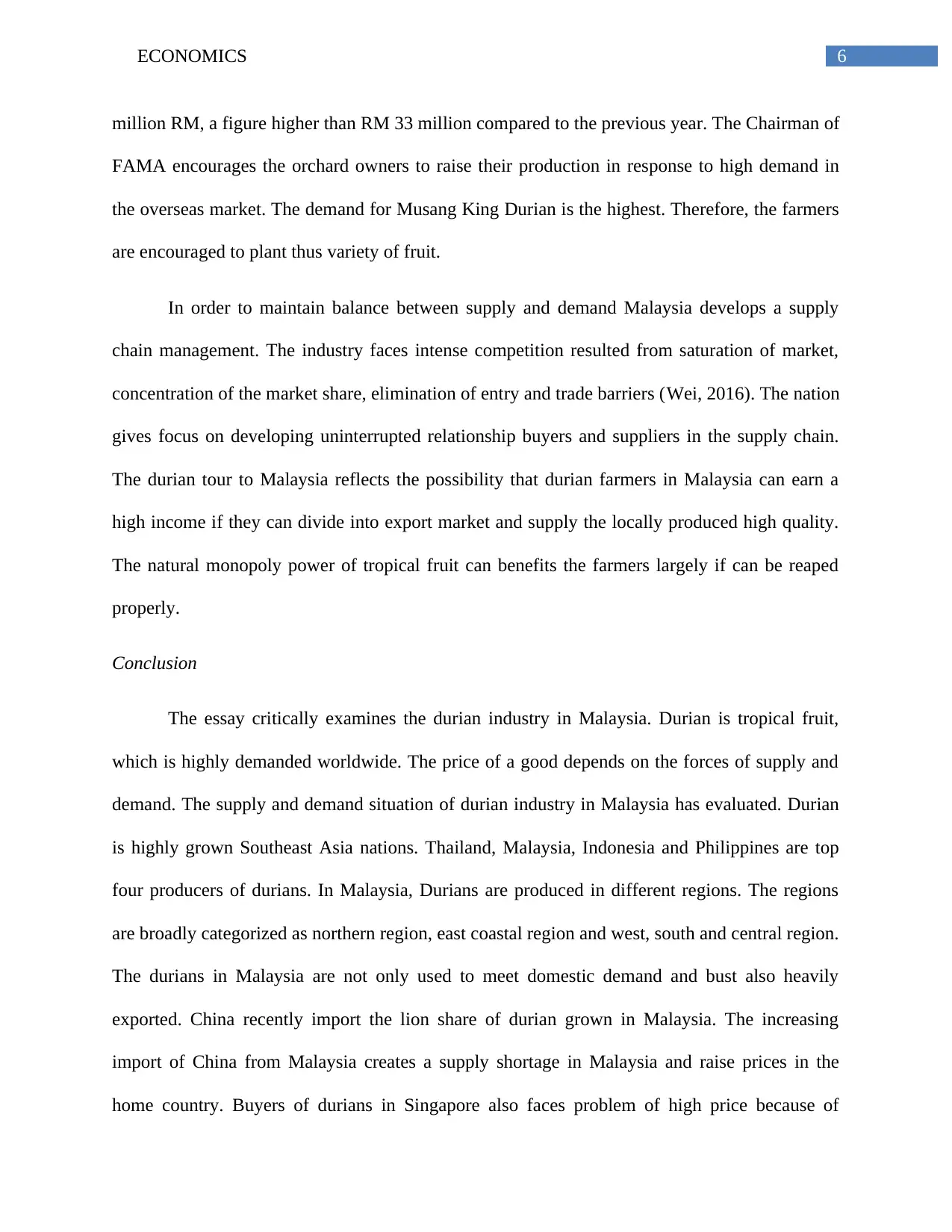
6ECONOMICS
million RM, a figure higher than RM 33 million compared to the previous year. The Chairman of
FAMA encourages the orchard owners to raise their production in response to high demand in
the overseas market. The demand for Musang King Durian is the highest. Therefore, the farmers
are encouraged to plant thus variety of fruit.
In order to maintain balance between supply and demand Malaysia develops a supply
chain management. The industry faces intense competition resulted from saturation of market,
concentration of the market share, elimination of entry and trade barriers (Wei, 2016). The nation
gives focus on developing uninterrupted relationship buyers and suppliers in the supply chain.
The durian tour to Malaysia reflects the possibility that durian farmers in Malaysia can earn a
high income if they can divide into export market and supply the locally produced high quality.
The natural monopoly power of tropical fruit can benefits the farmers largely if can be reaped
properly.
Conclusion
The essay critically examines the durian industry in Malaysia. Durian is tropical fruit,
which is highly demanded worldwide. The price of a good depends on the forces of supply and
demand. The supply and demand situation of durian industry in Malaysia has evaluated. Durian
is highly grown Southeast Asia nations. Thailand, Malaysia, Indonesia and Philippines are top
four producers of durians. In Malaysia, Durians are produced in different regions. The regions
are broadly categorized as northern region, east coastal region and west, south and central region.
The durians in Malaysia are not only used to meet domestic demand and bust also heavily
exported. China recently import the lion share of durian grown in Malaysia. The increasing
import of China from Malaysia creates a supply shortage in Malaysia and raise prices in the
home country. Buyers of durians in Singapore also faces problem of high price because of
million RM, a figure higher than RM 33 million compared to the previous year. The Chairman of
FAMA encourages the orchard owners to raise their production in response to high demand in
the overseas market. The demand for Musang King Durian is the highest. Therefore, the farmers
are encouraged to plant thus variety of fruit.
In order to maintain balance between supply and demand Malaysia develops a supply
chain management. The industry faces intense competition resulted from saturation of market,
concentration of the market share, elimination of entry and trade barriers (Wei, 2016). The nation
gives focus on developing uninterrupted relationship buyers and suppliers in the supply chain.
The durian tour to Malaysia reflects the possibility that durian farmers in Malaysia can earn a
high income if they can divide into export market and supply the locally produced high quality.
The natural monopoly power of tropical fruit can benefits the farmers largely if can be reaped
properly.
Conclusion
The essay critically examines the durian industry in Malaysia. Durian is tropical fruit,
which is highly demanded worldwide. The price of a good depends on the forces of supply and
demand. The supply and demand situation of durian industry in Malaysia has evaluated. Durian
is highly grown Southeast Asia nations. Thailand, Malaysia, Indonesia and Philippines are top
four producers of durians. In Malaysia, Durians are produced in different regions. The regions
are broadly categorized as northern region, east coastal region and west, south and central region.
The durians in Malaysia are not only used to meet domestic demand and bust also heavily
exported. China recently import the lion share of durian grown in Malaysia. The increasing
import of China from Malaysia creates a supply shortage in Malaysia and raise prices in the
home country. Buyers of durians in Singapore also faces problem of high price because of
Paraphrase This Document
Need a fresh take? Get an instant paraphrase of this document with our AI Paraphraser
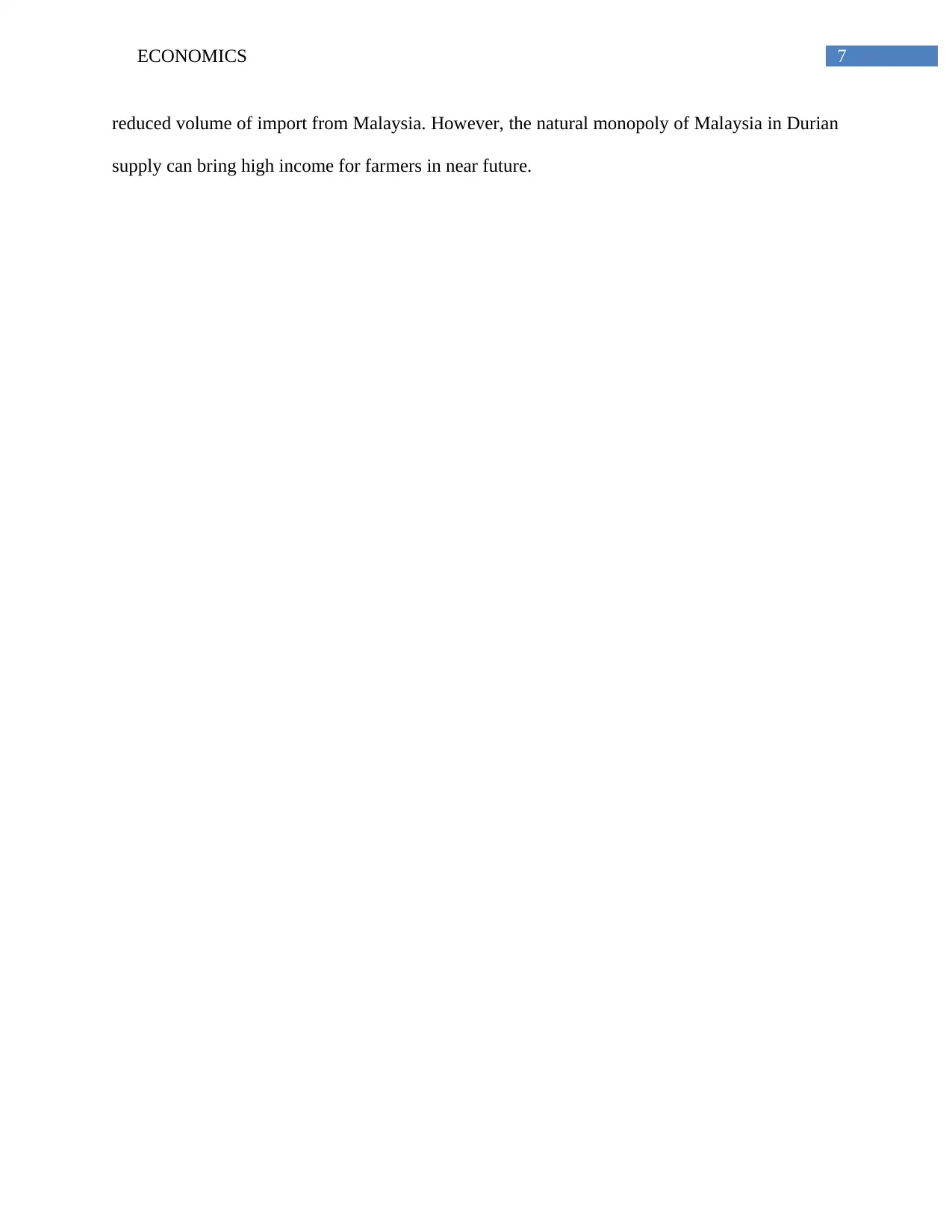
7ECONOMICS
reduced volume of import from Malaysia. However, the natural monopoly of Malaysia in Durian
supply can bring high income for farmers in near future.
reduced volume of import from Malaysia. However, the natural monopoly of Malaysia in Durian
supply can bring high income for farmers in near future.
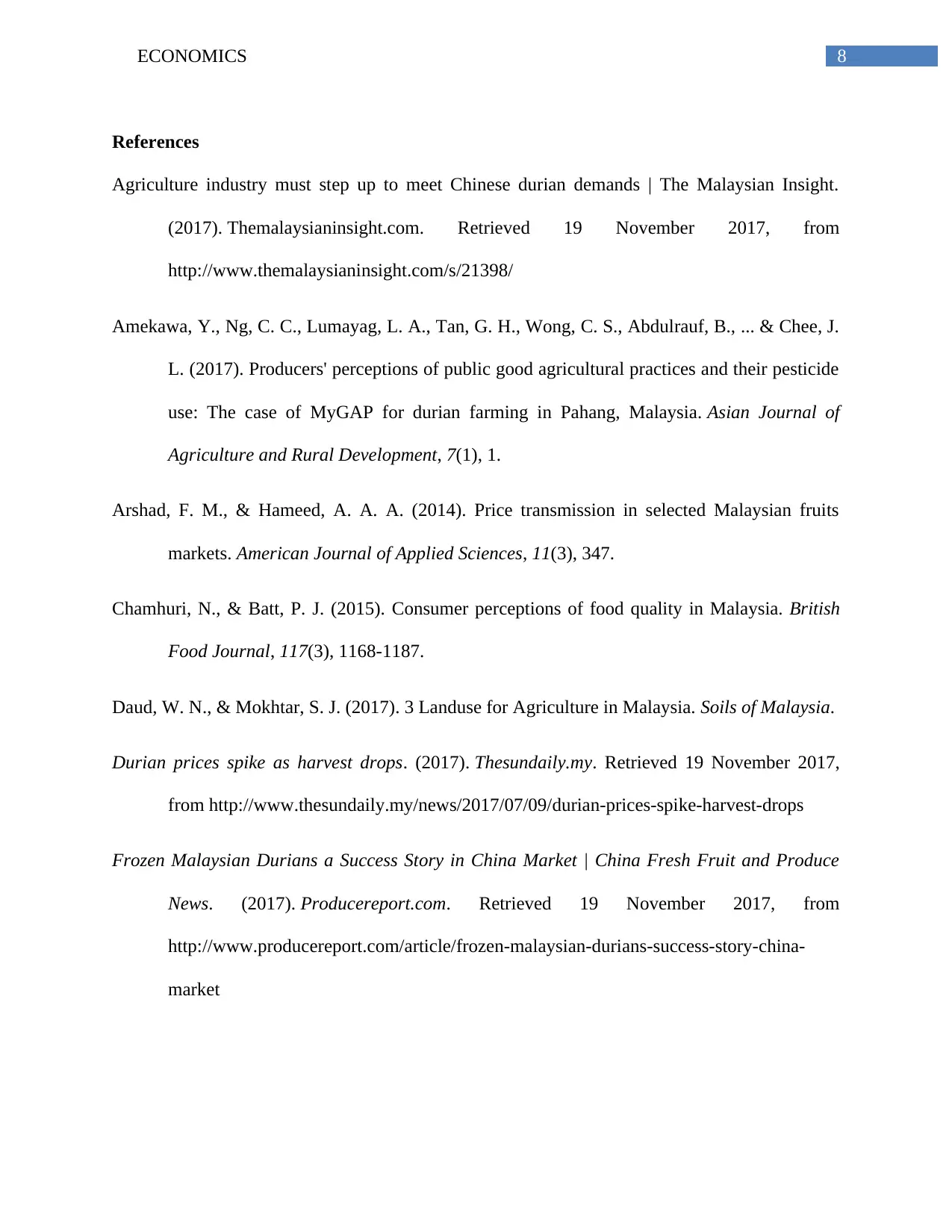
8ECONOMICS
References
Agriculture industry must step up to meet Chinese durian demands | The Malaysian Insight.
(2017). Themalaysianinsight.com. Retrieved 19 November 2017, from
http://www.themalaysianinsight.com/s/21398/
Amekawa, Y., Ng, C. C., Lumayag, L. A., Tan, G. H., Wong, C. S., Abdulrauf, B., ... & Chee, J.
L. (2017). Producers' perceptions of public good agricultural practices and their pesticide
use: The case of MyGAP for durian farming in Pahang, Malaysia. Asian Journal of
Agriculture and Rural Development, 7(1), 1.
Arshad, F. M., & Hameed, A. A. A. (2014). Price transmission in selected Malaysian fruits
markets. American Journal of Applied Sciences, 11(3), 347.
Chamhuri, N., & Batt, P. J. (2015). Consumer perceptions of food quality in Malaysia. British
Food Journal, 117(3), 1168-1187.
Daud, W. N., & Mokhtar, S. J. (2017). 3 Landuse for Agriculture in Malaysia. Soils of Malaysia.
Durian prices spike as harvest drops. (2017). Thesundaily.my. Retrieved 19 November 2017,
from http://www.thesundaily.my/news/2017/07/09/durian-prices-spike-harvest-drops
Frozen Malaysian Durians a Success Story in China Market | China Fresh Fruit and Produce
News. (2017). Producereport.com. Retrieved 19 November 2017, from
http://www.producereport.com/article/frozen-malaysian-durians-success-story-china-
market
References
Agriculture industry must step up to meet Chinese durian demands | The Malaysian Insight.
(2017). Themalaysianinsight.com. Retrieved 19 November 2017, from
http://www.themalaysianinsight.com/s/21398/
Amekawa, Y., Ng, C. C., Lumayag, L. A., Tan, G. H., Wong, C. S., Abdulrauf, B., ... & Chee, J.
L. (2017). Producers' perceptions of public good agricultural practices and their pesticide
use: The case of MyGAP for durian farming in Pahang, Malaysia. Asian Journal of
Agriculture and Rural Development, 7(1), 1.
Arshad, F. M., & Hameed, A. A. A. (2014). Price transmission in selected Malaysian fruits
markets. American Journal of Applied Sciences, 11(3), 347.
Chamhuri, N., & Batt, P. J. (2015). Consumer perceptions of food quality in Malaysia. British
Food Journal, 117(3), 1168-1187.
Daud, W. N., & Mokhtar, S. J. (2017). 3 Landuse for Agriculture in Malaysia. Soils of Malaysia.
Durian prices spike as harvest drops. (2017). Thesundaily.my. Retrieved 19 November 2017,
from http://www.thesundaily.my/news/2017/07/09/durian-prices-spike-harvest-drops
Frozen Malaysian Durians a Success Story in China Market | China Fresh Fruit and Produce
News. (2017). Producereport.com. Retrieved 19 November 2017, from
http://www.producereport.com/article/frozen-malaysian-durians-success-story-china-
market
⊘ This is a preview!⊘
Do you want full access?
Subscribe today to unlock all pages.

Trusted by 1+ million students worldwide
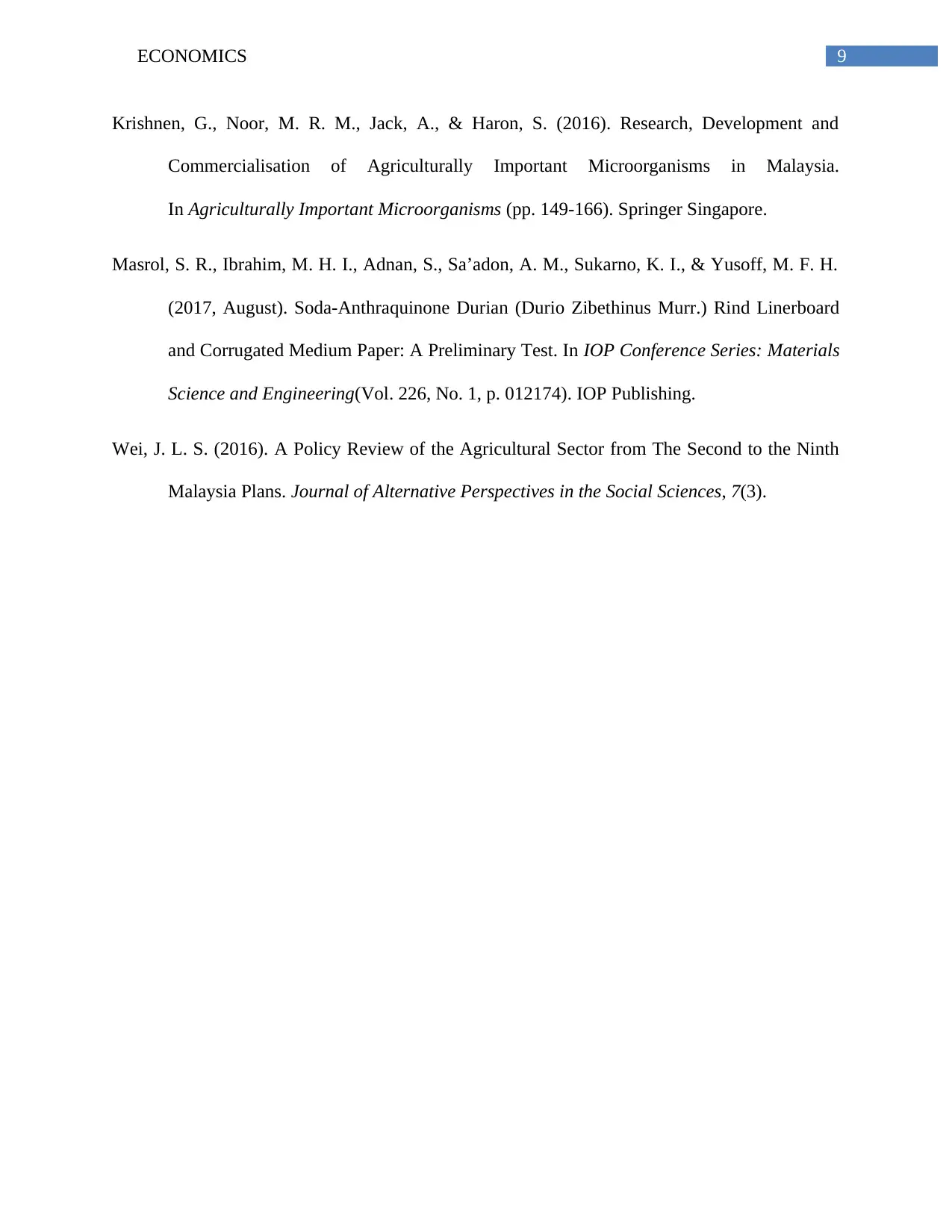
9ECONOMICS
Krishnen, G., Noor, M. R. M., Jack, A., & Haron, S. (2016). Research, Development and
Commercialisation of Agriculturally Important Microorganisms in Malaysia.
In Agriculturally Important Microorganisms (pp. 149-166). Springer Singapore.
Masrol, S. R., Ibrahim, M. H. I., Adnan, S., Sa’adon, A. M., Sukarno, K. I., & Yusoff, M. F. H.
(2017, August). Soda-Anthraquinone Durian (Durio Zibethinus Murr.) Rind Linerboard
and Corrugated Medium Paper: A Preliminary Test. In IOP Conference Series: Materials
Science and Engineering(Vol. 226, No. 1, p. 012174). IOP Publishing.
Wei, J. L. S. (2016). A Policy Review of the Agricultural Sector from The Second to the Ninth
Malaysia Plans. Journal of Alternative Perspectives in the Social Sciences, 7(3).
Krishnen, G., Noor, M. R. M., Jack, A., & Haron, S. (2016). Research, Development and
Commercialisation of Agriculturally Important Microorganisms in Malaysia.
In Agriculturally Important Microorganisms (pp. 149-166). Springer Singapore.
Masrol, S. R., Ibrahim, M. H. I., Adnan, S., Sa’adon, A. M., Sukarno, K. I., & Yusoff, M. F. H.
(2017, August). Soda-Anthraquinone Durian (Durio Zibethinus Murr.) Rind Linerboard
and Corrugated Medium Paper: A Preliminary Test. In IOP Conference Series: Materials
Science and Engineering(Vol. 226, No. 1, p. 012174). IOP Publishing.
Wei, J. L. S. (2016). A Policy Review of the Agricultural Sector from The Second to the Ninth
Malaysia Plans. Journal of Alternative Perspectives in the Social Sciences, 7(3).
1 out of 10
Your All-in-One AI-Powered Toolkit for Academic Success.
+13062052269
info@desklib.com
Available 24*7 on WhatsApp / Email
![[object Object]](/_next/static/media/star-bottom.7253800d.svg)
Unlock your academic potential
Copyright © 2020–2025 A2Z Services. All Rights Reserved. Developed and managed by ZUCOL.